U.S. Department of Transportation
Federal Highway Administration
1200 New Jersey Avenue, SE
Washington, DC 20590
202-366-4000
Focus
| Accelerating Infrastructure Innovations |
Publication Number: FHWA-HRT-07-017
Date: September 2007
For the Hawaii Department of Transportation (HDOT), a technology scanning tour to the mainland resulted in a new approach to managing and preserving Hawaii's pavements. The idea for the scanning tour came from a new Pavement Preservation Task Force formed in May 2005 that was charged with identifying improved methods to manage pavements in Hawaii. The task force includes representatives from HDOT, the Federal Highway Administration (FHWA), the Hawaii Asphalt Paving Industry (HAPI), and the Cement and Concrete Products Industry of Hawaii. In September 2006, members of the task force launched the scanning tour to visit four State highway agencies over a period of 10 days.
In stops in Washington State, California, Nevada, and Texas, participants held discussions with key decisionmakers from State departments of transportation and the pavement industry to learn more about agency organization, pavement management, project selection, ongoing research, and thin surface treatments and treatment selection. Working with both the transportation agencies and industry, task force members saw how a mix of fixes could be used effectively to maintain a pavement network at a generally lower cost and with reduced delays for the traveling public and reduced exposure and risk for motorists and highway workers. The task force also visited pavement projects and treatment test sites in California and Texas.
In Washington State, Linda Pierce, Pavement Engineer for the Washington State Department of Transportation (WSDOT), highlighted the importance of a formal definition of pavement preservation and maintenance. Pierce noted that up until 1971, WSDOT practiced a "worst first" approach to managing pavements-that is, fixing the most seriously and obviously deteriorated parts of its road networks first. However, in 1971, WSDOT switched to an approach based on lowest life-cycle costs (LLCC), which considers the life cycle and costs of projects rather than just the severity of pavement conditions. This change has resulted in a dramatic increase of pavements rated to be in average and above average condition. Project selection on the basis of LLCC is now required by legislation.
"The scanning tour acted as the catalyst to move Hawaii's pavement preservation program to the next level." |
WSDOT's pavement preservation program for hot-mix asphalt (HMA) pavements is based on thin (3.8 cm (1.5 in)) overlays, either placed on top of the existing pavement surface or applied in a mill-and-fill operation. The average HMA pavement life is 16 years on the western side of the State and 12.5 years on the eastern side (due to differing traffic levels and environment). One of WSDOT's significant preservation initiatives is a plan to place chip seals on all appropriate pavements, along with a legislative education program in the areas of LLCC, pavement design and performance, and the effects of studded tire wear.
Texas's pavement preservation program began 20 years ago and has had strong implementation by each of the Texas Department of Transportation's (TxDOT) 25 districts. The agency uses a variety of preservation techniques, with the most common being seal coating. The seal coats are used to seal cracks and improve skid resistance and are expected to last about 6 to 8 years.
Also supporting TxDOT's pavement preservation activities is the Texas Pavement Preservation Center. The center opened in August 2005 as a joint collaboration between Texas A&M's Texas Transportation Institute and the University of Texas-Austin's Center for Transportation. At the center, practitioners can gain training, perform research, and learn about new technology in the pavement industry.
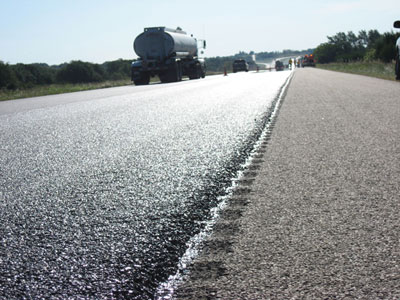 |
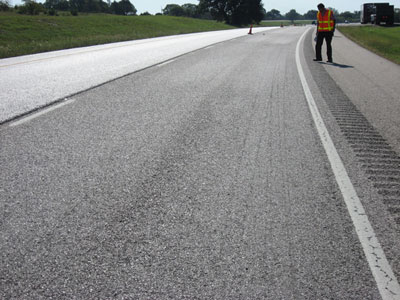 |
| The team observes an ultrathin bonded wearing course on I-10 near San Antonio, TX. |
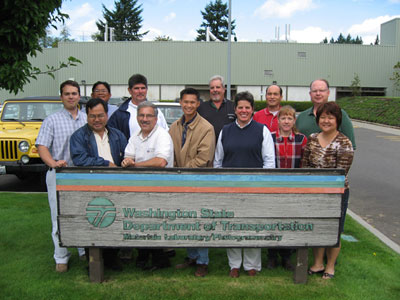 |
| The Hawaii scanning tour team visits the Washington State Department of Transportation. |
In California, the main issue facing the State's pavement preservation program is consistent funding. Currently, the California Department of Transportation (Caltrans) has a legislative requirement to develop a 5-year maintenance plan. The maintenance plan helps to educate legislators about the importance of pavement preservation, thus building support for moving away from the concept of "worst first." The plan also makes Caltrans more aware of which maintenance areas are costing the most money. Steve Takigawa from Caltrans noted that one of the main goals of his department is to stop just spending money and instead invest it wisely. Caltrans is also receiving assistance from the new California Pavement Preservation Center, which opened in July 2006 at the California State University, Chico (see March 2007 Focus).
The Nevada Department of Transportation (NDOT) has a highly centralized pavement preservation program. In November and December of each year, all NDOT districts review their roads, identify maintenance strategies, and coordinate with NDOT's headquarters office to prioritize projects. By June or July, NDOT has decided on the pavement preservation program and the districts receive funding. The program currently consists primarily of HMA overlays, milling, and recycling. Also used are crack seals, chip seals, slurry seals, and microsurfacing.
Dean Weitzel, Chief Materials Engineer at NDOT, noted that two keys to the success of Nevada's program are good communication and the placement of NDOT's Geotechnical, Pavement Design, and Pavement Management offices under the Materials office. Another key is support. "Without the support of the administration, districts, and engineers, it would be very difficult to implement any kind of program," said Weitzel.
To keep track of inventory information on pavements, including performance histories, current conditions, and models to project future performance, each of the agencies visited uses a pavement management system (PMS).
WSDOT has a full-featured PMS, which has been developed and refined over a period of more than 30 years. The agency uses the PMS to monitor system performance, predict future performance, and help determine when pavement sections are candidates for treatment. In Nevada, the PMS is used to determine whether specific pavement treatments are effective, while in Texas the Pavement Management office's regular pavement surveys are reliable enough so that the Maintenance Department is considering discontinuing its separate maintenance surveys. Caltrans, meanwhile, measures ride quality with a high-speed profiler and reports the results according to the International Roughness Index (IRI), in addition to its visual data collection effort.
As scanning tour discussions highlighted, a PMS is important in developing realistic projections of budget needs to meet program objectives or in predicting the effect of budget shortfalls, thus helping agencies demonstrate the effectiveness of a pavement preservation strategy and the importance of a dedicated pavement preservation program. By investing in roads while they are still in good condition, roadway lives can be substantially extended at a comparatively low cost, rather than having emergency repairs become the standard and more expensive solution.
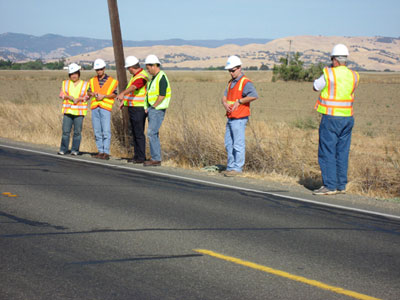 |
| Team members visit a Caltrans rubberized treatment test site on SR 16 in Yolo County, CA. |
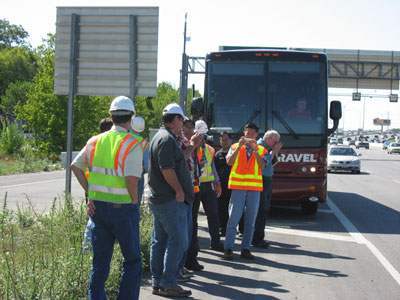 |
| As part of its tour, the team stops on I-10 in San Antonio, TX. |
Following the tour, HDOT, FHWA, HAPI, and the Cement and Concrete Products Industry of Hawaii signed a partnering agreement to support the development of a pavement preservation program in Hawaii. Hawaii Governor Linda Lingle recognized the partnering efforts in an October 2006 letter to the Pavement Preservation Task Force, noting that, "By making a commitment to this preservation and the application of a variety of innovative techniques and strategies, we can best position ourselves to provide a better investment and ride quality for the people of our state."
Since returning from the scanning tour, HDOT has begun to implement a pavement preservation program, including two pilot projects that have been bid that will use slurry seals as a preventive maintenance treatment. Construction is scheduled to begin in October. "Initiating the use of slurry seals will provide us with another tool for our toolbox," said JoAnne Nakamura of HDOT.
"The scanning tour acted as the catalyst to move Hawaii's pavement preservation program to the next level," adds Pat Phung of FHWA's Hawaii Division office.
HDOT also recently sponsored a pilot session of FHWA's revised National Highway Institute course on Pavement Preservation Concepts and Treatments. "The pilot course was a great success, especially in enhancing the awareness of pavement preservation in Hawaii," said Nakamura.
For more information on FHWA's pavement preservation program or the HDOT pavement preservation scanning tour, contact Pat Phung in FHWA's Hawaii Division office, 808-541-2700, ext. 305 (email: pat.phung@fhwa.dot.gov), or Joseph Gregory at FHWA, 202-366-1557 (email: joseph.gregory@fhwa.dot.gov). To learn more about Hawaii's pavement preservation initiatives, contact JoAnne Nakamura at HDOT, 808-832-3556, ext. 229 (email: joanne.nakamura@hawaii.gov).